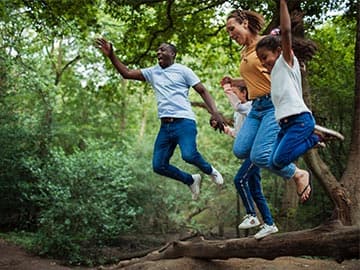Osgood-Schlatter's Disease: The causes & treatment
Published on 12/08/22 by Felicity Farrell
Clinically reviewed on 12/08/22 by Oliver Atkinson MCSP
What is Osgood-Schlatter’s Disease?
Osgood-Schlatter’s Disease (OSD) is inflammation of the growth plate at the top of the tibia, or shin bone, usually where the tendon meets the bone at the front of the knee.
Growth plates are found in children up to the age of approximately 17 and are areas of new active bone growth at the end of bones. They are made up of cartilage and harden to bone when a child has finished growing. Due to their soft nature, they are particularly vulnerable to injuries. These injuries are often diagnosed as “growing pains”.
What causes OSD?
OSD commonly occurs in active, sporty teenagers and children who are going through a growth spurt, and symptoms therefore usually appear around puberty. More commonly it occurs in taller children on one knee, but both knees can be affected.
Sports and activities that place a lot of impact through the knee such as running, football, tennis and rugby put extra stress on the growth plate and quadriceps tendon which causes the inflammation and pain.

What are the symptoms of OSD?
The most common symptoms are:
Tenderness and swelling at the top of the shin bone towards the front of the knee
A bony lump that is painful to touch in this location
Increase in pain and swelling when doing activities such as running, walking, and jumping
How does OSD get diagnosed?
Due to the obvious signs and symptoms, a reliable diagnosis can often be made by a GP or Physiotherapist through taking an accurate patient history and through simple tests such as looking at or pressing on the knee.
No x-rays or scans are necessary.

What is the treatment for OSD?
Rest will initially help symptoms settle but we know that’s not always practical for children and teenagers - particularly those who are active and/or have sporting commitments. In this case, it’s important to manage the symptoms so that they can continue with minimal pain.
Some things that can help are:
Holding an ice pack on the affected area when sore and just after activity for around 20 minutes
Use of painkillers such as paracetamol as directed (get advice from your doctor for longer term use)
Taking longer rest periods between sporting events
Modifying training to lower impact activities such as swimming and cycling as opposed to running or weights.
It is also advised to get guidance and an exercise plan from a Chartered Physiotherapist who can help you come up with a plan for modified activity. Certain stretches and strengthening exercises can work to alleviate and eliminate symptoms within a few months and prevent reoccurrence through the rest of adolescence.

How can Simplyhealth help?
It’s important to remember the quicker children get diagnosed and treated, the more likely their symptoms won’t bother them as much and their usual activity can continue. Our Health Plans include video GP and video physiotherapy assessment services, to help you proactively take control of yours and your family’s health. We also offer money back towards private physiotherapy treatment so that you can physically see a professional quickly, without worrying about the costs. It’s as easy as 1, 2 fixed knee!
Health cover for the family
To enjoy 24/7 online GP access* and much more, get our 1-2-3 Health Plan from £29 a month for parent and child cover.
Related articles and guides

Your guide to the online GP
Everything you need to know about having a doctor's appointment through video call.

Your summer guide to family health
Sun safety, benefits of having a health plan for your kids, and activities for all the family.
*Please note: the online GP service is unavailable on Christmas Day.